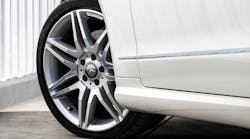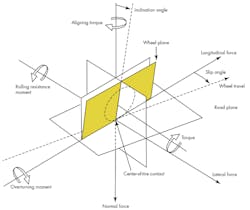The resistance of automotive tires to rolling eats up anywhere from 20% to 50% of the energy used by the car. So if auto and tire engineers could cut the rolling resistance in passenger-car tires by 10%, gas mileage would improve by 3%.
But what contributes to rolling resistance? Experts say that 1% to 5% of it stems from aerodynamic drag. Another 9% to 10% comes from road friction. And the remaining 85% to 95% is due to internal friction or hysteresis of materials. Engineers cannot do much about aerodynamic losses, and some degree of road friction is needed to keep cars and trucks on the road and not sliding off of them. That’s why they concentrate on hysteresis losses, those caused chiefly by the flexing or the tire materials as the vehicle moves, to cut rolling resistance.
Here are several of the most critical factors to hysteretic losses and what could be done to reduce them along with rolling resistance.
Load: Road resistance increases directly with load. The coefficient is 0.01. This means a 1,000-lb increase in a car’s load will increase rolling resistance by 10 lb. Reducing this component of resistance depends more on vehicle weight than the tires.
Slip Angle: The angle between the plane of the tire and the direction the car is traveling is called the slip or scrub angle. It can increase when a car takes a corner. The greater the slip angle, the higher the rolling resistance. Toe-in, the amount the plane of the front wheels are angled toward the vehicles centerline, improves driving stability but adds to rolling resistance. Little can be done to lower the resistance caused by slip angle other than to ensure the car’s wheels stay properly aligned.
Speed: Between 5 and 55 mph, rolling resistance only goes up by about 1 lb. But above those speeds, tires contribute more to rolling resistance. Therefore, lower speed limits might help.
Time-to-reach equilibrium: Tires have their lowest rolling resistance for a given set of operating conditions when the tire is in thermal equilibrium. This means the heat generated by internal friction is offset by the cooling effects of the tire moving through the air. It takes a while for equilibrium to be established, but when it does, rolling resistance drops by 30%. Unfortunately, most car trips are less than 20 minutes long, too short a period for tires to reach equilibrium.
Changing tire designs so that equilibrium is established sooner may be a practical approach. Or it might be practical to make tires rated for short-trip city driving and different ones for freeway driving.
Tread depth: Rolling resistance decreases as a tire wears. That’s because as the amount of tire material that flexes and then rebounds is reduced, so to do hysteretic losses. Unfortunately, many adverse factors affect wear and engineers cannot take advantage of them to reduce rolling resistance.
Torque: A tire’s rolling resistance decreases when under a slight amount of torque. Therefore, tires have less rolling resistance when accelerating or decelerating. Engineers can do little to exploit this factor in passenger cars, but it might be used on trucks. For example, a dual-axle truck would have lower rolling resistance if both axles were driven. But the benefits of less rolling resistance would have to compensate for frictional losses in a more complex drive train.
Then there’s the road itself: A significant cause of rolling resistance that has yet to be fully addressed is road deflection. All vehicles press down on the roads they travel on, deflecting or pushing it down. This means tires are always going up a slight but continuous hill. For concrete highways, they deflection is about 0.03 in. For cold asphalt, it climbs to 0.06 in. And for hot asphalt, it can be as high as 1 in.

